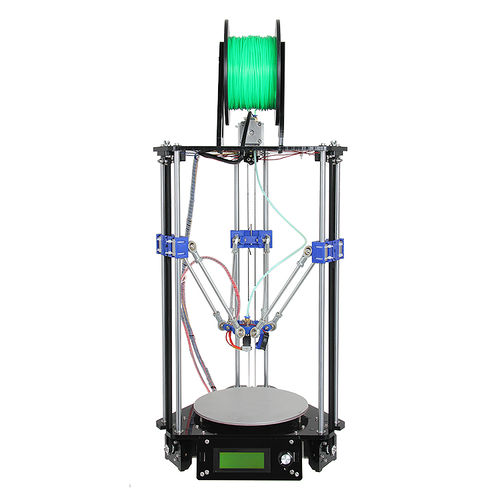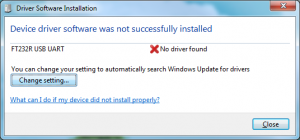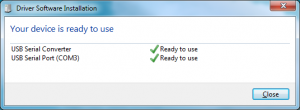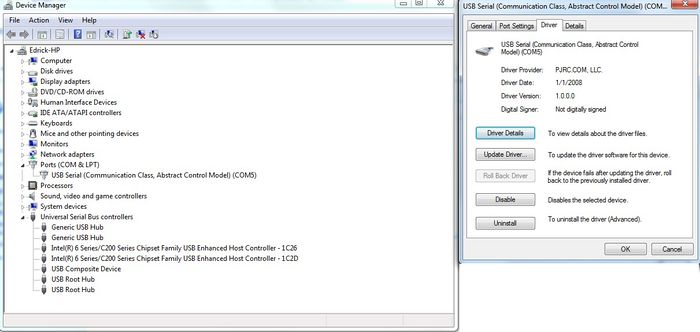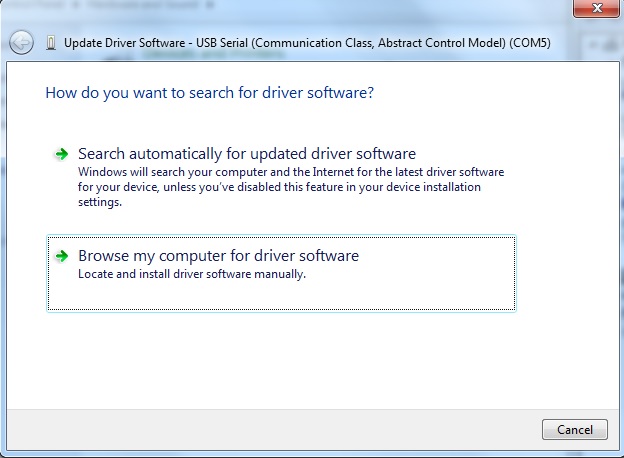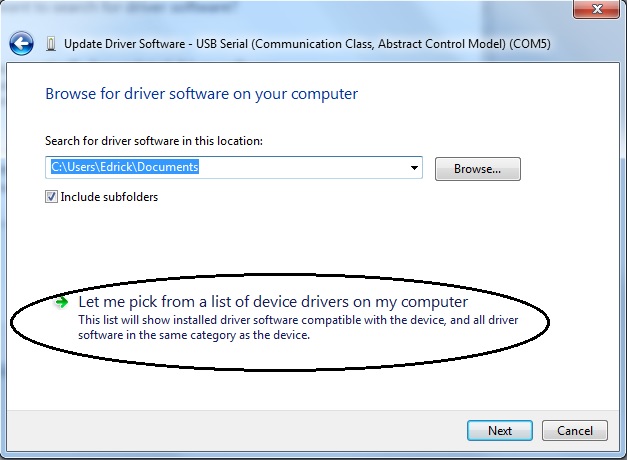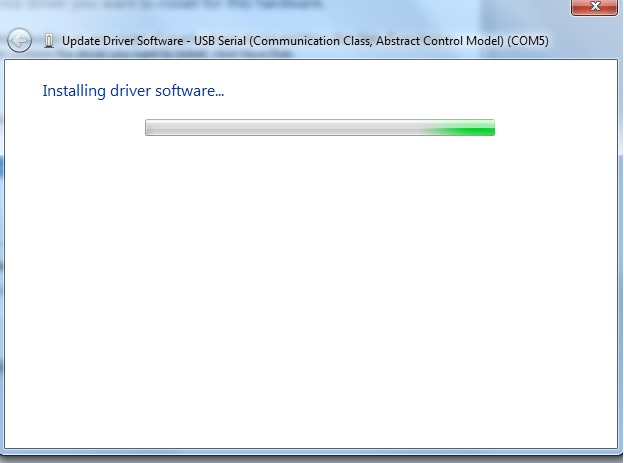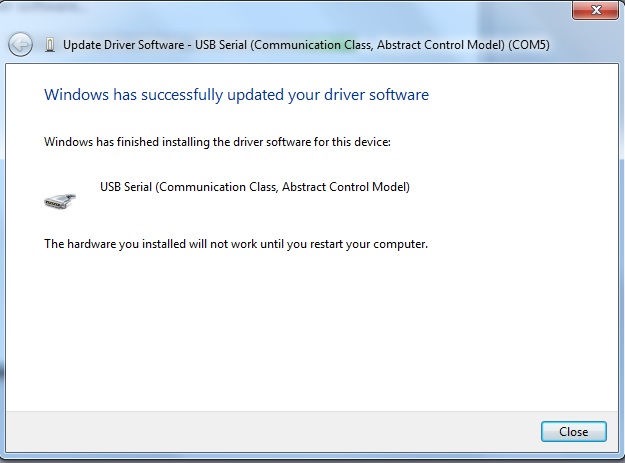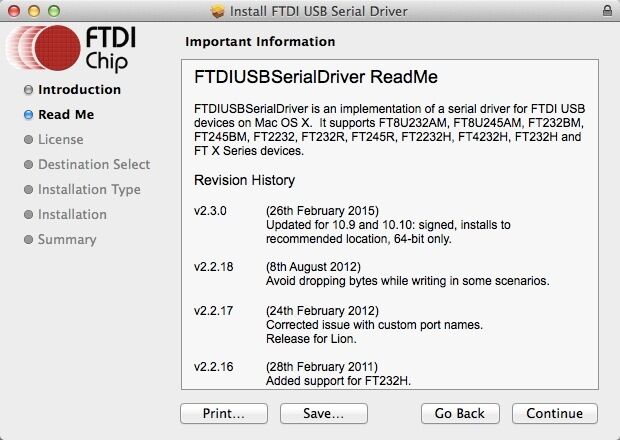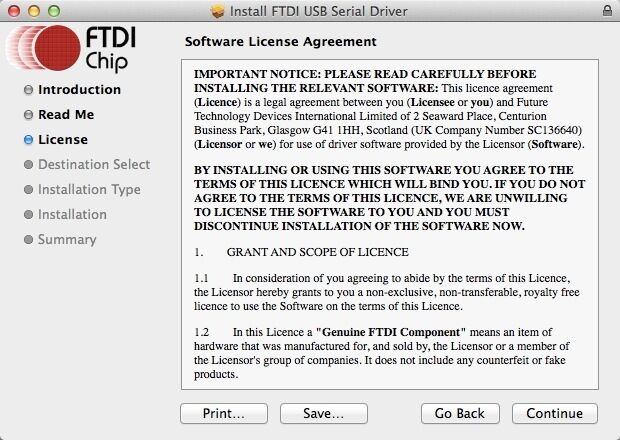Difference between revisions of "Delta Rostock mini G2"
(→install drivers and software) |
(→install drivers and software) |
||
| Line 96: | Line 96: | ||
[http://www.ftdichip.com/Drivers/CDM/CDM%20v2.12.00%20WHQL%20Certified.exe here]. | [http://www.ftdichip.com/Drivers/CDM/CDM%20v2.12.00%20WHQL%20Certified.exe here]. | ||
| + | |||
| + | If the driver was not automatically installed, you may see this screen: | ||
| + | |||
| + | [[File:INSTALL 1.png]] | ||
| + | |||
| + | In this case, | ||
| + | a. Click “Change Settings…” | ||
| + | b. Select “Install driver software from Windows Update”. | ||
| + | c. Click “Save Changes”. The FTDI drivers should now install successfully. | ||
| + | |||
| + | [[File:INSTALL 2.png]] | ||
| + | |||
| + | |||
| + | Attention: For those having difficulty selecting your COM port | ||
| + | |||
| + | If you have installed the USB serial driver successfully and you are still not able to connenct to your printer in Repetier Host, then windows has not recognized the newly installed driver. | ||
| + | In Repetier Host, you may even notice an error message that is similar to this one: | ||
| + | |||
| + | Serial com error:System.IO.Ports.SerialErrorReceivedEventArgs | ||
| + | |||
| + | In some situations, a computer running windows will not automatically recognize a newly installed Serial driver. This means that you will have to update your newly installed driver manually. | ||
| + | |||
| + | To manually update the driver, you will first need to plug the USB cable into your printer and attache the other end directly to one of your computer’s USB ports. Now, enter the ‘Device Manager’ in Windows and navigate to the hardware category called Ports (COM & LPT) and then left click on it once. You should notice the Ports category expand to reveal a Sub-Category called USB Serial (Communication Class, Abstract Control Model) (COM X); where X is the COM port number. You should be looking for that COM port number in Repetier Host after this procedure is completed; which can be found in “Printer Settings.” | ||
| + | |||
| + | [[File:INSTALL3.jpg|700px|]] | ||
| + | |||
| + | You will need to right click on the USB Serial Sub-class and select proprties. In the drivers tab you will find a selection to update drivers, click on Update Drivers to access the next menu. | ||
| + | |||
| + | Now that you have selected which driver to update, you will have to tell Windows where the “updated” driver can be found. You should be presented with two options. Select “Browse my computer for driver software” to locate and install the driver software manually. | ||
| + | |||
| + | [[File:Install 4.jpg]] | ||
| + | |||
| + | Next, you will be greeted by a menu that allows you to “Browse for driver software on your computer” You will be presented with two choices, select “Let me pick from a list of device drivers on my computer.” Now select the Serial port device and proceed with the installation. | ||
| + | |||
| + | [[File:Install 5.jpg]] | ||
| + | |||
| + | That is pretty much all there is to it. You will then see an installation indicator bar. | ||
| + | |||
| + | [[File:Install 6.jpg]] | ||
| + | |||
| + | Once the installation is complete you will be notified that “Windows has successfully updated your driver software.” You will be prompted to restart your computer; you should do so. | ||
| + | |||
| + | [[File:Install 7.jpg]] | ||
| + | |||
| + | |||
| + | '''Macbook (OS X) Manual Install'''<br> | ||
| + | Download link of driver: http://www.ftdichip.com/Drivers/VCP.htm <br> | ||
| + | Download the driver that is compatible with system version. | ||
| + | |||
| + | Open the downloaded file, you will see a .pkg file, Open "FTDIUSBSerial.pkg"<br> | ||
| + | [[File:FTDI for mac 1.jpg]] | ||
| + | |||
| + | Click "Continue" in Instruction.<br> | ||
| + | [[File:FTDI for mac 2.jpg]] | ||
| + | |||
| + | Click "Continue" in Read me.<br> | ||
| + | [[File:FTDI for mac 3.jpg]] | ||
| + | |||
| + | Click "Continue" in License.<br> | ||
| + | [[File:FTDI for mac 4.jpg]] | ||
| + | |||
| + | Click "Agree" to continue installation.<br> | ||
| + | [[File:FTDI for mac 5.jpg]] | ||
| + | |||
| + | Select the installing destination and click "Continue".<br> | ||
| + | [[File:FTDI for mac 6.jpg]] | ||
| + | |||
| + | Click "Install" in Installatin Type.<br> | ||
| + | [[File:FTDI for mac 7.jpg]] | ||
| + | |||
| + | Mac will start to install the driver:<br> | ||
| + | [[File:FTDI for mac 8.jpg]]<br> | ||
| + | [[File:FTDI for mac 9.jpg]] | ||
| + | |||
| + | Once your computer restarts, try selecting the appropriate COM port and baud rate in Repetier Host and then connect. | ||
Revision as of 02:58, 25 May 2015
This Rostock mini G2 is a new upgraded delta 3D printer based on the modified design of the Geeetech Delta Rostock mini generation 1.
On the whole, the Rostock mini G2 succeeds the advantages of the previous version like small physical footprint, simple but really rigid frame, high positioning accuracy, flexible effectors, and very similar specification except that we add some innovative design.
This G2 is powered by our newly designed control system—GT2560 that supports 2 extruders and eliminates the complicated wiring of Mega2560+Ramps 1.4 and it is more space-saving and convenient.
We also add an auto-leveling auto-calibration device for G2;which means you do not have to adjust it every time before you start printing, after the first assembly work, you can almost plug and play.
In terms of printing filament, apart from PLA and ABS, G2 supports Nylon and wood filament, which enables more possibilities to create 3D printing project.
This G2 is also improved with a build-on LCD control panel; you can monitor the printing process in real time and with a SD card it can realize stand-alone printing, very convenient.
Main features:
1. New updated control system.
2. Auto-leveling and auto-calibration.
3. More flexible effectors and diagonal rods.
4. More fluent printing process and higher precession.
5. Support PLA, ABS, Nylon and Wood filament.
6. Further simplified structure and enhanced stability.
Specifications:
Print size (X Y Z): 150 x 150 x 210mm
Chassis: laser -cut acrylic plate
The Layer Thickness: 0.1mm
Layer Resolution: 0.1mm
Filament Diameter: 1.75, 0.3mm
Nozzle Diameter: 0.3, 0.35, 0.4, 0.5mm
Print Speed: 60 to 120 mm/sec
Print Plate Size: 210 x 3mm
Print Plate (Build Platform): aluminum plate + MK2A heatbed
XYZ Bearings: carbon steel
Stepper Motors: 1.8° step angle with 1/16 micro-stepping
Max Heated Bed Temp: about 110 ℃
Max Extruder Temp: about 240 ℃
AC Input: 115V/1.5A 230V/0.75A
Output:DC12V/0-15A
No. of Extruders: 1
Connectivity (Interface): USB, SD Card
Electronics: GT2560
3D printing Software: Repetier Host
CAD Input data file format supported: STL, G code
Client Operating System: Windows, Linux, Mac
Machine Dimensions: 320 x 320 x 870mm
Machine weight: 7.5kg
Shipping box dimensions:
Shipping box weight:
building instruction
For detailed building instruction, please visit here.
install drivers and software
Install the drivers
Installing Drivers Before printing, you’ll need to install drivers. The kind of driver that a Rostock mini G2 and G2s requires in order to operate properly is called a USB Serial Driver. A USB Serial Driver is software that establishes a COM port.
Plug the USB into a USB port on your computer. Windows Update should automatically find and install the drivers. You’re done with installing the drivers!
Windows Manual Install Note: In some cases the drivers will not install on their own. The drivers for Windows can be found
here.
If the driver was not automatically installed, you may see this screen:
In this case, a. Click “Change Settings…” b. Select “Install driver software from Windows Update”. c. Click “Save Changes”. The FTDI drivers should now install successfully.
Attention: For those having difficulty selecting your COM port
If you have installed the USB serial driver successfully and you are still not able to connenct to your printer in Repetier Host, then windows has not recognized the newly installed driver. In Repetier Host, you may even notice an error message that is similar to this one:
Serial com error:System.IO.Ports.SerialErrorReceivedEventArgs
In some situations, a computer running windows will not automatically recognize a newly installed Serial driver. This means that you will have to update your newly installed driver manually.
To manually update the driver, you will first need to plug the USB cable into your printer and attache the other end directly to one of your computer’s USB ports. Now, enter the ‘Device Manager’ in Windows and navigate to the hardware category called Ports (COM & LPT) and then left click on it once. You should notice the Ports category expand to reveal a Sub-Category called USB Serial (Communication Class, Abstract Control Model) (COM X); where X is the COM port number. You should be looking for that COM port number in Repetier Host after this procedure is completed; which can be found in “Printer Settings.”
You will need to right click on the USB Serial Sub-class and select proprties. In the drivers tab you will find a selection to update drivers, click on Update Drivers to access the next menu.
Now that you have selected which driver to update, you will have to tell Windows where the “updated” driver can be found. You should be presented with two options. Select “Browse my computer for driver software” to locate and install the driver software manually.
Next, you will be greeted by a menu that allows you to “Browse for driver software on your computer” You will be presented with two choices, select “Let me pick from a list of device drivers on my computer.” Now select the Serial port device and proceed with the installation.
That is pretty much all there is to it. You will then see an installation indicator bar.
Once the installation is complete you will be notified that “Windows has successfully updated your driver software.” You will be prompted to restart your computer; you should do so.
Macbook (OS X) Manual Install
Download link of driver: http://www.ftdichip.com/Drivers/VCP.htm
Download the driver that is compatible with system version.
Open the downloaded file, you will see a .pkg file, Open "FTDIUSBSerial.pkg"
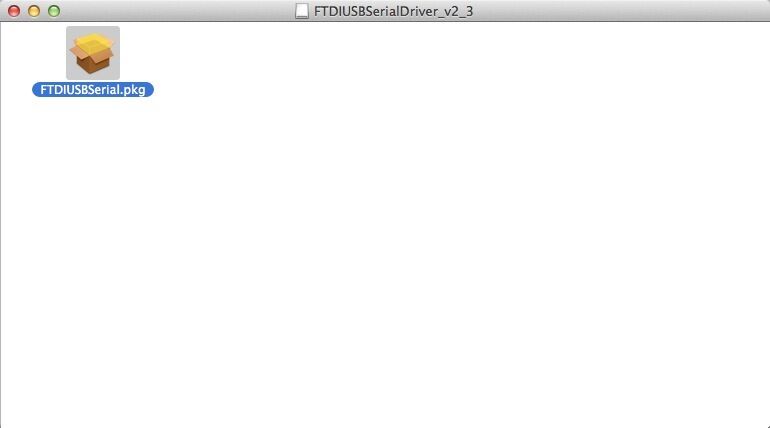
Click "Continue" in Instruction.
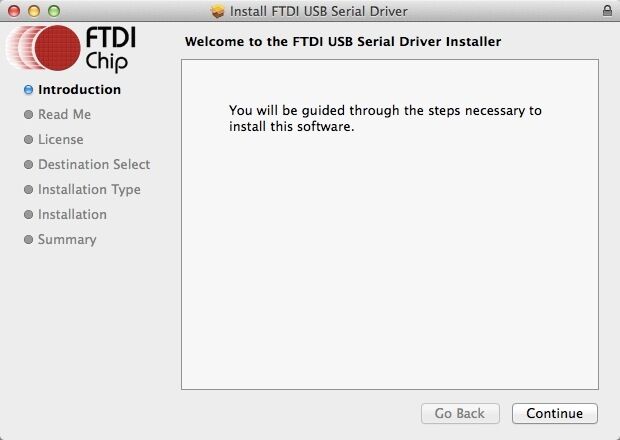
Click "Agree" to continue installation.
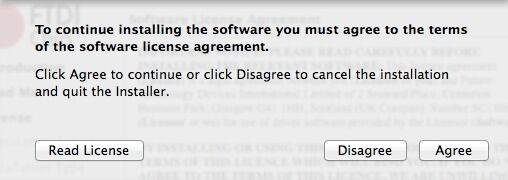
Select the installing destination and click "Continue".
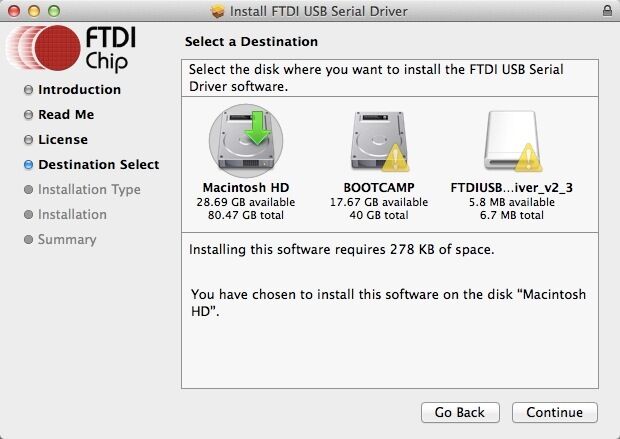
Click "Install" in Installatin Type.
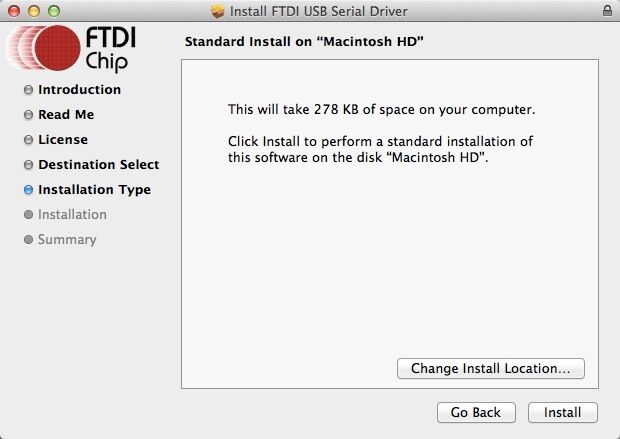
Mac will start to install the driver:
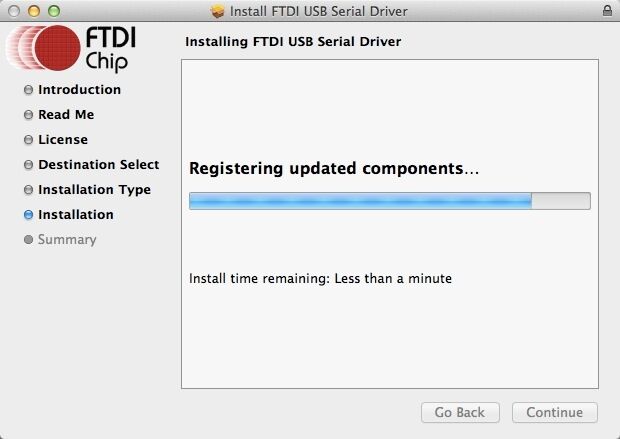
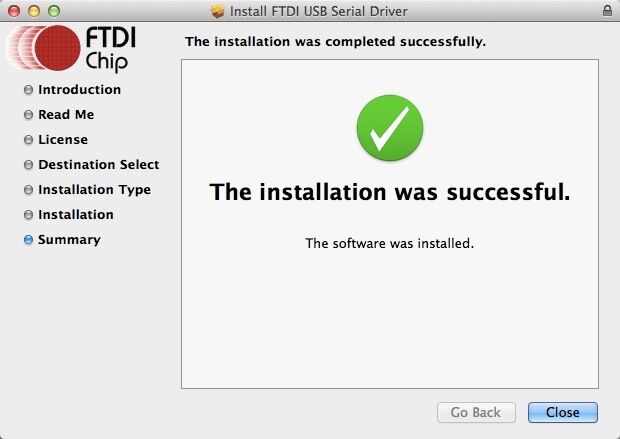
Once your computer restarts, try selecting the appropriate COM port and baud rate in Repetier Host and then connect.
